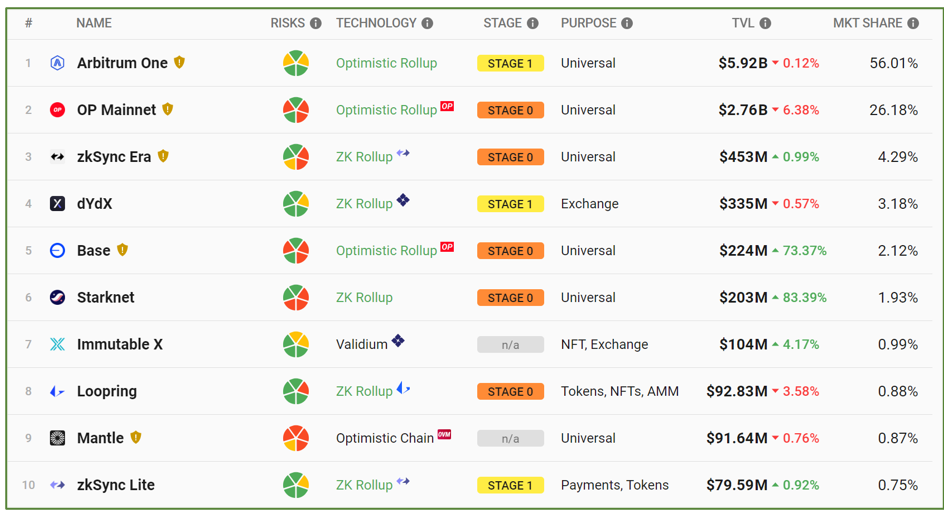L2s Could Be the Next Big Crypto Narrative
 |
| By Bruce Ng |
In the short run, crypto is driven by narratives, with casual investors, traders and speculators all piling in on the latest hype.
If you recall, back in May, there was a huge surge in memecoins. For a quick refresher, you can check out my colleague Jurica Dujmovic’s rundown of this phenomenon here.
During the memecoin frenzy, there was a tsunami of trading on the Ethereum (ETH, “B”) network, which reminded investors of the key benefits of one particular sector.
And since we are currently experiencing a lull in the crypto market, this is the perfect opportunity to look ahead and research which sectors to load up on right now for the next bull run.
You see, a few months ago, trading volume overloaded capacity on the Ethereum network so much that transaction processing slowed dramatically. Of course, network usage fees also shot up — as high as $10 per transaction and $100 to swap coins.
Sound familiar? Something similar happened when the non-fungible token craze overloaded Ethereum back in 2021.
Sure, the hope was that with the latest ETH upgrade, the network would be able to avoid bottlenecks like these. However, demand still outpaced what the Ethereum base chain was able to support.
Indeed, the narrative that pervades the crypto space is that Ethereum is once again becoming too expensive to use.
If fees on Ethereum continue to be expensive, there is a possibility that a new narrative will emerge. One where Layer-2 solutions will be key to restoring cheap, fast transactions on the Ethereum blockchain.
As a reminder, Layer-2s are scaling solutions — separate chains built on top of the Ethereum base chain that settle transactions independently and then record those transactions on the Ethereum blockchain at regular intervals.
Here’s a less technical explanation: Think of the Ethereum network as a busy highway.
Right now, the high trading volume is akin to rush hour traffic leaving a major city, where many cars (transactions) are trying to reach their destinations (to be confirmed on the blockchain).
However, the highway has limited capacity. So, there are traffic jams and delays.
Layer-2 solutions are like high-speed trains that run parallel to the highway, but with much greater capacity. Instead of every driver needing to compete for limited space on the highway, some can take the train — and bypass the congestion.
This allows L2s to process transactions faster and cheaper than Ethereum.
In recent years, Ethereum’s network congestion has encouraged the development of a variety of L2s. Let’s explore a few of them to find out which ones seem the most promising.
Top Layer-2 Blockchains by Total Value of Assets Locked
Now, total value of assets locked is a good measure of adoption, which is why this is an important statistic to keep an eye on.
Currently, Arbitrum (ARB, Not Yet Rated) leads the pack with a whopping 56.01% of the TVL market share.
In second place is Optimism (OP, Not Yet Rated). But it’s lagging way behind, with only a 26.18% share.
In comparison, other L2 solutions lag even further and are not serious competitors right now.
That doesn’t mean they won’t grow in the future, though. New solutions like zkSync Era could potentially give Arbitrum a run for its money.
But for now, it’s relatively new and still in testing. So, it’s too early to see how strong of a competitor zkSync is going to be.
Moreover, because of the network effects in crypto, being first can often be better than being the best.
Why Arbitrum Is Top Dog
From the TVL comparison chart, it’s clear that Arbitrum is the leader of the pack.
On this blockchain, some transactions are "rolled up" into a single batch and confirmed off-chain. This process is known as optimistic rollup, where transactions are initially assumed to be valid.
To continue our train analogy from before, this is the equivalent of an express train. In other words, it can skip stations to reach its destination faster.
Then, they’re sent to the Ethereum base chain for verification and settlement. At this step, those transactions can be disputed if they turn out to be fraudulent.
By using Arbitrum, users can enjoy faster and cheaper transactions than on Ethereum … without having to compete for limited space on the main network.
And those increased transaction speeds on Arbitrum have a compounding effect. Say, for example, Ethereum does 10 transactions per second. And Arbitrum also does 10 transactions per second.
These figures compound to provide 10 × 10 = 100 transactions per second.
Additionally, fees on Arbitrum are vastly cheaper than Ethereum.

As a result, it’s no surprise that this radical cost savings has opened the floodgates to a whole new universe of decentralized applications.
Attracted by the high processing speeds and low transaction fees on Arbitrum, many developers have chosen this platform to build dApps such as …
- Conventional decentralized exchanges like Uniswap (UNI, “B”) and Curve (CRV, “B-”), which you can use to swap assets.
- Perpetual DEXes like GMX and Chronos, which allow derivatives trading.
- Lending protocols like Aave (AAVE, “B-”) that allow you to stake assets for a yield and borrow on those staked assets to invest in other assets.
- Gambling platforms that are decentralized and provably fair, which is also known as GambleFi. One example is WINR Protocol.
Overall, even though the crypto market is stagnant and stuck in a tight trading range right now, that doesn’t mean there aren’t other opportunities out there for you to pursue.
We will continuously be on the lookout for up-and-coming projects that have potential and sectors that are of interest.
So, be sure to check in with us at Weiss Crypto Daily to figure out how to put yourself in the best position for the next bull run.
Best,
Bruce Ng

